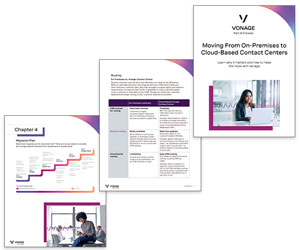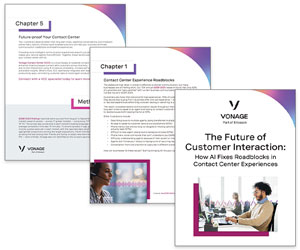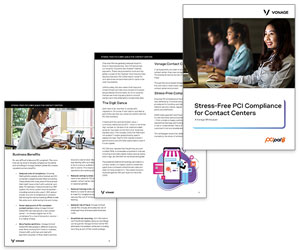Vonage explores what customer experience management really means today — and how AI is reshaping the way businesses connect, engage, and grow.
Customer experience management (CXM) is much more than a buzzword: it’s a real, tangible way to grow your company, beat your competitors, and encourage your customers to keep coming back for more. Happy, satisfied, and loyal customers are the lifeblood of any thriving business, regardless of size, industry, and location.
Ensuring they always have a top-notch experience whenever they interact with your brand across different channels and platforms is paramount to success.
If you’re interested in discovering the ins and outs of customer experience management, including its benefits, key elements, and how AI can revolutionize it, dive into our comprehensive guide to CXM.
What is Customer Experience Management (CXM)?
Let’s start with a simple customer experience management definition. Customer experience management (often also known as CEM or CXM) refers to a strategy aimed at managing and boosting the customer journey across all touchpoints and other types of interactions with a company.
On a surface level, this might seem incredibly similar to the very basic definition of customer service. However, over the past few years, the role of CXM has evolved significantly, taking on a range of much more specific and sophisticated features and functions.
For example, while in the past the focus was mostly on delivering a good product or service, today companies are all about crafting an unforgettable, personalized, and meaningful experience that offers the customer exactly what they want and need – and leaves them eager to come back for more.
Customer experience management is usually a strategy characterized by a holistic approach (it covers the entirety of the customer journey, for a seamless and cohesive experience across all touchpoints), a strong focus on the customer (it highlights the importance of personalization, expectations, and behaviours), and the increasingly essential role of integrated data (helping predict, manage, and improve outcomes).
Some typical customer experience management examples include:
- Personalized customer experiences and recommendations, such as those offered by streaming services like Netflix or online marketplaces like Amazon
- Omnichannel support, offering seamless customer support across a range of channels and platforms
- Advanced and proactive services, including those provided by banks using AI-driven tools to spot any suspicious account activity
- Real-time customer feedback, like surveys and questionnaires sent by hotels during (and not after) a guest’s stay
- Virtual agent assistance (provided by services like Vonage) to route calls to the right agent in order to offer them on-the-fly access to a customer’s profile (and, as a result, deliver excellent, customized service).
Customer Experience Management vs. Customer Relationship Management: Key Difference
When discussing the customer experience management framework, it can be all too easy to get it mixed up with another essential component of a company’s customer-facing strategy, namely, customer relationship management.
The terms are very similar, but while the two areas do have some aspects in common, they also present important differences.
Here’s a handy side-by-side comparison table that shows the main differences between the two.
| Customer Experience Management (CXM) | Customer Relationship Management (CRM) |
|---|---|
| Focuses on nurturing customer loyalty | Focuses on building customer relations |
| It gets monitored at every touch point | It gets monitored at every communication |
| It aims to boost the customer experience | It aims to boost revenues |
| Mostly leveraged by company leaders and data analysts | Mostly leveraged by customer facing teams |
The Importance of Customer Experience Management
Sure, improving customer experience is one of the main reasons why most brands put a customer experience management plan in place, but the benefits go way beyond this. Let’s find out more.
It Maximizes Brand Equity
When talking about brand equity, we’re not simply describing the value a brand has for consumers. We’re also referring to the feelings and emotions that are evoked in consumers when simply thinking about a brand.
Brands that promise, and deliver, exceptional products or services, nurture their customers, are present and responsive, and offer genuine value are much more likely to gain fans and advocates.
These customers, in turn, are more likely to leave great reviews, participate in activities and initiatives launched by the brand, and maybe even join a loyalty or referral program.
All this, ultimately, creates a truly holistic, top-quality customer experience management program, which can maximize brand equity.
It Enhances Customer Retention
What happens when a customer is very happy with the product or service you sold them? If they need that product or service again, your brand will now be at the forefront of their mind, and they will likely come back to you, bypassing your competitors.
The result is higher customer retention, which can often lead to more sales, better (and easier) ROI, and increased customer lifetime value.
It Promotes Customer Engagement
When we talked about the main examples of CXM, we mentioned omnichannel support and services. This is vital, as your brand needs to convey the same values, vision, mission, and messages regardless of the platform it uses to communicate with its audience.
A further good step in this direction is the adoption of specific tactics and techniques to maximize customer engagement in relation to the channel or platform your customers are using the most.
For example, imagine your CXM team has noticed that one of your customer segments usually interacts with you on social media.
To boost engagement on this specific channel, they could put in place enticing, valuable, and proactive measures through things like gamification, challenges and competitions, and user-generated content (UGC).
It Boosts Your Customer Lifetime Value
Earlier, we mentioned customer lifetime value, but it’s worth talking about it a bit more. First of all, let’s define what customer lifetime value is: This expression refers to the total amount of earnings you’ll make from a customer over the entire time they buy from you.
As expected, better customer lifetime value comes from repeat business (i.e. returning customers), which is why boosting retention is fundamental to increasing this factor.
With a solid customer experience management plan in place, you’ll be able to craft excellent, customized, and relevant experiences for all your customers across the various interactions they have with your brand.
As a result, these people will keep buying from you, strengthening and lifting your customer lifetime value.
It Cuts Customer Churn
Lastly, what usually comes with better customer retention and higher customer lifetime value? Lower customer churn, of course.
The more you succeed at retaining those hard-won, happy customers, the less likely you are to lose them to a savvier competitor.
Things like email newsletters, special deals and promotions, personalized recommendations, and other marketing and communication updates fully tailored to your customers are all crucial parts of a well-thought-out customer experience management strategy, and are all incredibly helpful in keeping your customers satisfied and cutting churn.
Key Elements of a Customer Experience Management Strategy
Now you know what customer experience management is and why it’s so important for businesses. But how do you put together a foolproof customer experience management strategy? Let’s find out.
1. Research and Develop Your Customer Persona
As with many other marketing strategies, your customer experience management plan must always begin with in-depth research of your target audience.
After all, how can you craft fantastic experiences if you don’t even know, exactly, who these experiences are for?
So, start with figuring out who your audience is, their needs, what pain points they are trying to solve, what preferences they exhibit, and how they behave when interacting with your brand.
This will enable you to create a very detailed customer persona to represent each one of your different customer segments.
2. Establish Clear Goals
Next, you’ll want to set up a range of clear objectives you plan to target with your CXM strategy. Avoid being generic by stating things like “improving the customer experience.”
A simple and effective way to build a list of goals is by using the popular SMART goals framework. Each objective should be specific, measurable, achievable, relevant, and time-bound.
In our example above, the rather vague and nonspecific goal of “improving the customer experience” could become something like “improving customer satisfaction scores by 10% in the next three months.”
3. Map Out the Customer Journey
At this point, you should be ready to start mapping out the customer journey. This involves identifying all the relevant touchpoints and other interactions between your company and your customers across an array of channels.
Visually representing this can help you better understand what’s currently working and what could be improved in terms of managing all these different touchpoints and interactions.
4. Create a Personalized Omnichannel Customer Experience
It’s now time to get all these pieces together and put your strategy to work. Examine each touchpoint/interaction (website, social media, email, blog, customer support, and maybe even your AI-powered contact centre solution) and make sure they all provide the same high-quality, seamlessly consistent, and cohesive experience to your customers.
You’ll also want to start gathering data from each of these channels, as it will help you with the next – and final – step.
4. Keep Assessing, Improving, and Innovating
OK, so your customer experience management strategy is in place. But your work is not yet done! To find out whether the plan is performing as it should, you need to keep monitoring it, as well as be prepared to make any minor adjustments (or major, in some cases) if necessary.
You can do so with a customer experience management platform (CXM platform), as this will enable you to analyse vast amounts of data quickly, accurately, and cost-effectively.
How Customer Experience Management Software and AI Can Help
While you might be tempted to use your current CRM for customer experience management, the truth is that you’ll be better off leveraging a much more specific tool, such as customer experience management software, powered by the latest technology.
It’s no longer a mystery that cutting-edge tech like AI can transform customer experience management. But how does this happen, in practice?
Normally, these tools include capabilities such as automation, data analytics, sentiment analysis, and more, which help you provide customized, seamless, efficient, and top-quality service across all the relevant touchpoints.
This blog post has been re-published by kind permission of Vonage – View the Original Article
For more information about Vonage - visit the Vonage Website
Call Centre Helper is not responsible for the content of these guest blog posts. The opinions expressed in this article are those of the author, and do not necessarily reflect those of Call Centre Helper.
Author: Vonage
Reviewed by: Rachael Trickey
Published On: 18th Aug 2025
Read more about - Guest Blogs, Vonage






 Vonage is redefining business communications, helping enterprises use fully-integrated unified communications, contact centre and programmable communications solutions via APIs.
Vonage is redefining business communications, helping enterprises use fully-integrated unified communications, contact centre and programmable communications solutions via APIs. 


































